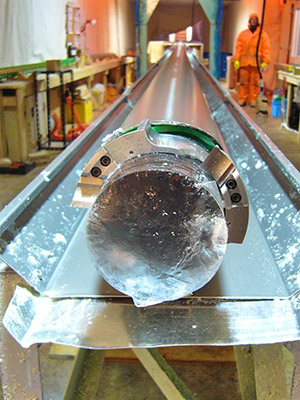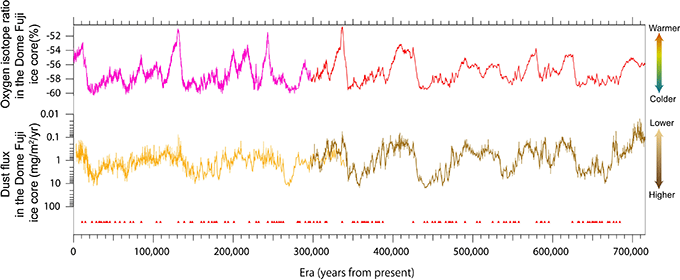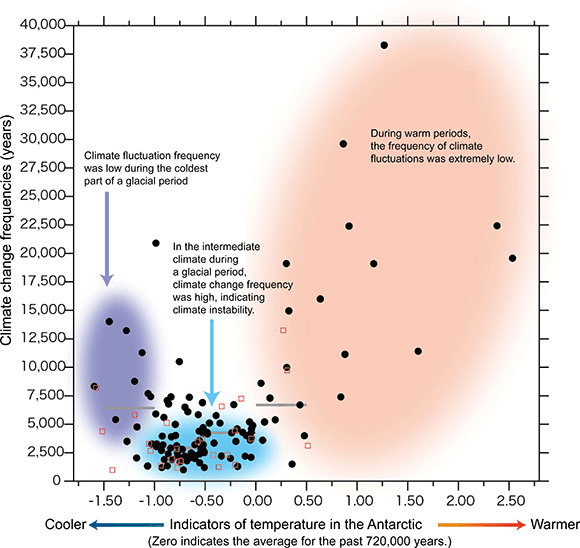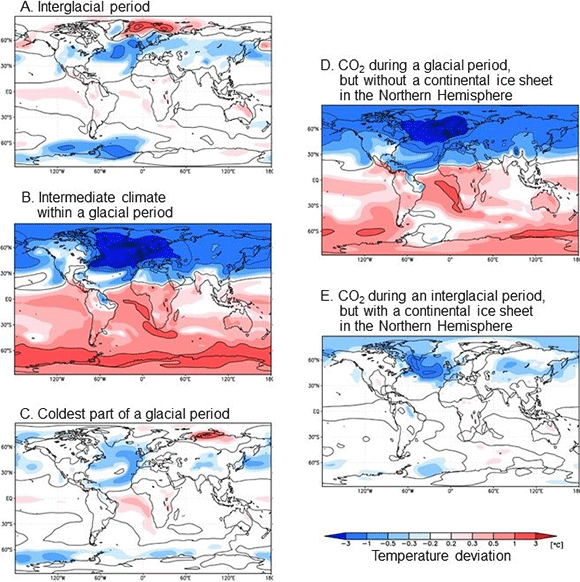National Institute of Polar Research
Climate instability over the past 720,000 years
Ice core analysis from Dome Fuji, Antarctica and climate simulation
Released on February 9, 2017 (in Japanese)
Posted on June 29, 2017
National Institute of Polar Research
Atmosphere and Ocean Research Institute, the University of Tokyo
Japan Agency for Marine-Earth Science and Technology
Hokkaido University
Nagoya University
Tohoku University
Kitami Institute of Technology
Hirosaki University
Tsukuba University
Kyoto University
Shinshu University
Yamagata University
University of the Ryukyus
A new analysis of an ice core from Dome Fuji in Antarctica, along with climate simulation results, shows a high degree of climate instability (that is, rapid climate fluctuations) within glacial periods with intermediate temperatures. This instability was attributed primarily to global cooling caused by a reduced greenhouse effect.
A research group formed by 64 researchers from the National Institute of Polar Research, the University of Tokyo, and other organizations analyzed atmospheric temperatures and dust for the past 720,000 years using an ice core obtained at Dome Fuji in Antarctica. Results indicate that when intermediate temperatures occurred within a glacial period, the climate was highly unstable and fluctuated. A climate simulation was also performed based on the Coupled Atmosphere-Ocean General Circulation Model, which revealed that the major cause of the observed climate instability was global cooling by a decline in the greenhouse effect.
Climate instability severely impacts both the Earth’s natural environment and human society. In the continued effort for understanding how global warming could affect climate instability, it is important to identify periods in the past that experienced climate instability. These periods need to be studied and modeled to clarify any potential causes of the observed instability. However, little progress has been made in improving our documenting and understanding of climate instability prior to the last glacial period.
The research groups of Dr. Kenji Kawamura and Dr. Hideaki Motoyama (National Institute of Polar Research) analyzed the Second Dome Fuji ice core (Fig.1) that were obtained as part of the Japanese Antarctic Research Expedition (JARE) between 2003 and 2007. Their team reproduced fluctuations in the air temperature and dust (solid particulate matter carried by the atmosphere) in the Antarctic for the past 720,000 years (Fig.2). They combined this with data from the Dome C ice core drilled by a European team to obtain highly robust paleoclimate data. They examined these data, discovering that for the past 720,000 years, the intermediate climate within glacial periods was marked by frequent climate fluctuations (Fig.3).
This raised a question: Why does the most instability occur when there is an intermediate climate during a glacial period, rather than during an interglacial period, such as we are currently experiencing, or during the coldest part of a glacial period? The research group of Dr. Ayako Abe-Ouchi (University of Tokyo) used a climate model (MIROC) to first reproduce three types of background climate conditions—the interglacial period, intermediate climate within a glacial period, and the coldest part of a glacial period. They then performed a simulation that added the same quantity of fresh water to the northern part of the North Atlantic Ocean in each of the three climate conditions. This simulation was performed using the Earth Simulator supercomputer at the Japan Agency for Marine-Earth Science and Technology (JAMSTEC). The simulation results indicated that the response to freshwater inflow is maximized during the intermediate climate that occurs within glacial periods, causing the climate to become unstable (Fig.4 A-C).
An important factor affecting climate instability is the vulnerability of Atlantic deep water circulation during global cooling resulting from a decrease in the atmospheric carbon dioxide concentration (Fig.4 D-E). Until now, the primary factor for climatic instability was thought to be the existence and instability of continental ice sheets in the Northern Hemisphere, but this experiment has revealed that carbon dioxide is another important factor, determining not only the average state of the climate, but also the long-term stability of the climate. These results also suggest that future stability in the present interglacial period, which has continued for more than 10,000 years, is not guaranteed. Indeed, if significant melting of the Greenland ice sheet occurs due to anthropogenic warming, it might destabilize the climate.
According to Dr. Kawamura, “Due to anthropogenic emissions, the atmospheric greenhouse gas concentrations have reached a level not seen over the past million years. Large climate components, such as ice sheets and the oceans that have vast size and longtime scales for variations, will undoubtedly change. It will become even more important to combine the climate reconstructions and numerical simulations for the periods when the global environment was much different than it is today, to understand the Earth system by verifying its mechanisms.”
The study results have been published in the on-line journal, Science Advances.

Figure 1. Ice Core from the Dome Fuji station.

Figure 2: Oxygen isotope ratio (an indicator of air temperature) and dust flux (an indicator of atmospheric particle concentrations) during the past 720,000 years obtained from the Antarctic Dome Fuji ice cores. The triangles at the bottom of the chart indicate the locations of warming peaks in the Antarctic as abstracted by this study.

Figure 3. Relationship between the frequency of climate fluctuations with temperatures in the Antarctic during the past 720,000 years obtained from analysis of Antarctic ice cores (black spots), as well as results for the final glacial period based on ice cores from Greenland (red squares). During the warm interglacial periods, and the coldest portion of a glacial period, the frequency of climate fluctuations was low, but during periods of intermediate temperatures within a glacial period, climate fluctuations occurred frequently and the climate was unstable.

Figure 4. Temperature deviations following the continuous addition of fresh water to the northern part of the North Atlantic for 500 years as simulated by the Coupled Atmosphere-Ocean Global Climate Model (MIROC), which was used to reproduce the atmospheric carbon dioxide concentrations and ice cover corresponding to three different climate conditions (A: an interglacial period, B: intermediate climate within a glacial period, and C: the coldest part of a glacial period). During the intermediate climate within glacial periods, the response was dramatic, with the Northern Hemisphere cooling and the southern hemisphere warming. Sensitivity tests using artificial conditions were also performed (D, E) in which the atmospheric carbon dioxide concentrations and ice-sheet coverage in the Northern Hemisphere from the interglacial periods were switched with those from the intermediate climate within glacial periods. The atmospheric carbon dioxide concentration appears to play a major role in increasing climate instability.
Published Paper
Journal: Science Advances, Vol. 3, no. 2, e1600446
Title: State dependence of climatic instability over the past 720,000 years from Antarctic ice cores and climate modeling
Authors:
Dome Fuji Ice Core Project Members:
Kenji Kawamura (1,2,3*), Ayako Abe-Ouchi (4,5*), Hideaki Motoyama (1,2*), Yutaka Ageta (6),Shuji Aoki (7), Nobuhiko Azuma (8), Yoshiyuki Fujii (1,2), Koji Fujita (6), Shuji Fujita (1,2), Kotaro Fukui (1†), Teruo Furukawa (1,2), Atsushi Furusaki (9), Kumiko Goto-Azuma (1,2), Ralf Greve (10), Motohiro Hirabayashi (1), Takeo Hondoh (10), Akira Hori (11), Shinichiro Horikawa (10‡), Kazuho Horiuchi (12), Makoto Igarashi (1), Yoshinori Iizuka (10), Takao Kameda (11), Hiroshi Kanda (1,2), Mika Kohno (1§), Takayuki Kuramoto (1), Yuki Matsushi (13||), Morihiro Miyahara (14), Takayuki Miyake (1), Atsushi Miyamoto (10), Yasuo Nagashima (15), Yoshiki Nakayama (16), Takakiyo Nakazawa (7), Fumio Nakazawa (1,2), Fumihiko Nishio (17), Ichio Obinata (18), Rumi Ohgaito (5), Akira Oka (4), Jun’ichi Okuno (1,2), Junichi Okuyama (10¶), Ikumi Oyabu (1), Frédéric Parrenin (19), Frank Pattyn (20), Fuyuki Saito (5), Takashi Saito (21), Takeshi Saito (10), Toshimitsu Sakurai (1#), Kimikazu Sasa (15), Hakime Seddik (10), Yasuyuki Shibata (22), Kunio Shinbori (10), Keisuke Suzuki (23), Toshitaka Suzuki (24), Akiyoshi Takahashi (14), Kunio Takahashi (5※), Shuhei Takahashi (11), Morimasa Takata (8), Yoichi Tanaka (25), Ryu Uemura (1,26), Genta Watanabe (27), Okitsugu Watanabe (28), Tetsuhide Yamasaki (14), Kotaro Yokoyama (29), Masakazu Yoshimori (30), Takayasu Yoshimoto (31)
*corresponding authors
1 National Institute of Polar Research, Research Organizations of Information and Systems, Japan
2 Department of Polar Science, Graduate University for Advanced Studies (SOKENDAI), Japan
3 Institute of Biogeosciences, Japan Agency for Marine-Earth Science and Technology, Japan
4 Atmosphere and Ocean Research Institute, University of Tokyo, Japan
5 Department of Integrated Climate Change Projection Research / Program for Risk Information on Climate Change, Japan Agency for Marine-Earth Science and Technology, Japan
6 Graduate School of Environmental Studies, Nagoya University, Japan
7 Graduate School of Science, Tohoku University, Japan
8 Department of Mechanical Engineering, Nagaoka University of Technology, Japan
9 Asahikawa National College of Technology, Japan
10 Institute of Low Temperature Science, Hokkaido University, Japan
11 Department of Civil and Environmental Engineering, Kitami Institute of Technology, Japan
12 Graduate School of Science and Technology, Hirosaki University, Japan
13 Tandem Accelerator, University of Tokyo, Japan
14 Geo Tecs Co. Ltd., Japan
15 AMS Group, Tandem Accelerator Complex, University of Tsukuba, Japan
16 3D Geoscience Inc., Japan
17 Center for Environmental Remote Sensing, Chiba University, Japan
18 Obinata Clinic, Japan
19 Univ. Grenoble Alpes, CNRS, IRD, IGE, France
20 Université Libre de Bruxelles, Belgium
21 Disaster Prevention Research Institute, Kyoto University, Japan
22 National Institute for Environmental Studies, Japan
23 Faculty of Science, Shinshu University, Japan
24 Faculty of Science, Yamagata University, Japan
25 Geosystems Inc., Japan
26 Department of Chemistry, Biology, and Marine Science, University of the Ryukyus, Japan
27 Chiken Consultants Co. Ltd., Japan
28 Graduate University for Advanced Studies (SOKENDAI), Japan
29 Hokuriku Research Center, National Agricultural Research Center, Japan
30 Faculty Environmental Earth Science, Hokkaido University, Japan
31 IOK/Kyushu Olympia Kogyo Co. Ltd., Japan
† Present affiliation: Tateyama Caldera Sabo Museum, Japan
‡ Present affiliation: Earthquake and Volcano Research Center, Graduate School of Environmental Studies, Nagoya University, Japan
§Present affiliation: Department of Geochemistry, Geoscience Center, University of Göttingen, Germany.
|| Present affiliation: Disaster Prevention Research Institute, Kyoto University, Japan
¶ Present affiliation: Advanced Applied Science Department, IHI Co., Japan
# Present affiliation: Civil Engineering Research Institute for Cold Region, Public Work Research Institute, Japan
※ Present affiliation: AdvanceSoft Corporation
Published date: February 8, 2017:
DOI: 10.1126/sciadv.1600446
URL: http://advances.sciencemag.org/content/3/2/e1600446
Funder
This study was supported by KAKENHI from the Japan Society for the Promotion of Science and MEXT (grant numbers 14GS0202, 15101001, 16201005, 18340135, 19201003, 21221002, 21671001, 22101005, 25241005, and 26241011) and an Environment Research and Technology Development Fund (S-10) of the Ministry of the Environment.
Contact
Public Relations Section, National Institute of Polar Research
E-mail: kofositu@nipr.ac.jp








